The "Value" of Multi-Million-Dollar Sports Venues
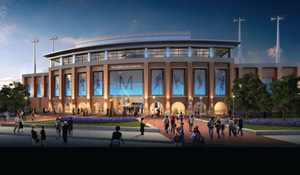
PHOTO COURTESY OF MCKINNEY INDEPENDENT SCHOOL DISTRICT
“Many school systems compete against each other for academic as well as athletic endeavors,” says Andy Miller, AIA, a project architect in the Indianapolis office of Fanning Howey, an architecture, engineering and design firm with offices across the country. “They are ultimately compared to each other and put in a position of having to keep up with the Jones’. I think it becomes a race to make sure that you have the most current facilities — as good as or better than what your competition has. So, there’s a trend that there is a competition for those tax-paying entities to be located in your school system. That’s a tough trend for some school administrators to overcome.”
Indeed, some would describe today’s sports venues as high-priced, extravagant and unnecessary. Others, however, argue that they construct only what is necessary to provide their students with high-quality, well-rounded education and that it is what their communities want, as indicated by the successful passing of bond issues to construct the facilities. Let’s take a look at two facilities, both are football stadiums, and you be the judge.
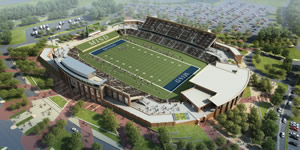
PHOTO COURTESY OF MCKINNEY INDEPENDENT SCHOOL DISTRICT
McKinney ISD (Texas) Stadium and Community Event Center
“As far back as 2000, the district approved funds for a new stadium,” begins Cody Cunningham, chief communications and support services officer for McKinney ISD in Texas. “During that time, we were going through a period of explosive growth, adding 1,500 to 2,000 new students per year. As opposed to allocating the bonding capacity to a stadium, we dedicated it to the construction of new schools.” It happened again in 2005 and 2011.
Then came a 2016, $220-million bond program. It was the district’s first available opportunity to consider if it could meet academic needs and, at the same time, add a facility that would meet the needs of the fine arts and athletics programs. The answer was yes. In fact, “One of the unique aspects of this bond program was that we were able to address facility needs while, at the same time, reduce the tax rate,” says Cunningham. “We have a reputation for being fiscally responsible, and we were retiring a significant amount of old bond debt.”
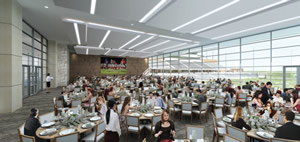
PHOTO COURTESY OF MCKINNEY INDEPENDENT SCHOOL DISTRICT
As a result, the district is in the midst of building a 12,000-seat, $70-million football stadium and community events center, scheduled for completion in March 2018. One unique detail is that, because multiple high schools will use the stadium for games, it was important that fans have an identical experience regardless of where they sit, so both sides — home and visitors — are identical.
A crucial design element is an 8,000-square-foot multipurpose event center with a wall of glass overlooking the stadium. Floating walls allow the space to be split into three separate rooms. When open, the center seats 500 at banquet rounds or 800 in rows. This multi-purpose space will be used for staff development, school board meetings and banquets, and is rentable by members of the community.
Cunningham indicates that the event center should be addressed as much as the stadium itself. “We have 40 to 60 athletic and 30 to 40 fine arts banquets each spring, held in leased space at local country clubs,” he observes. “All those functions will now be hosted at the event center. In fact, between the stadium and the event center, we see a facility that will be used all day, almost every day.”
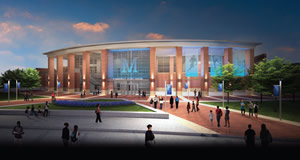
PHOTO COURTESY OF MCKINNEY INDEPENDENT SCHOOL DISTRICT
How does Cunningham respond when asked if the district is building the stadium to remain competitive with sports venues built or being built by other districts in Texas? In a straightforward manner: “I think there’s certainly a desire in our district to remain competitive in every aspect of what we provide our students and parents,” he says. “In this regard, we don’t view the stadium any differently than we do our other facilities. Our philosophy is we want to have first-class facilities in every part of our district.
“There is a link between the learning environment and the experience that students get,” Cunningham continues. “That philosophy does not change, regardless of what the facility is for. The stadium is an extension of a comprehensive education, not an add-on.”
Like for many districts, the stadium will be a Friday-night community-gathering place, with hundreds of students plugging into the game in different capacities, such as the dance team, cheerleaders, band, and broadcast students. “The community, saw a need for it, and they supported it,” says Cunningham. “We didn’t propose something they didn’t want. If they didn’t want it, it wouldn’t have passed.”
When people move to the North Dallas area, there is an expectation for academic rigor. “But there’s also an expectation for the types of programs that we offer our students, Cunningham acknowledges. “I believe that the facilities and the quality of the education we provide are a reason why so many people want to live here. So I think that, if we were sacrificing academics or neglecting other needs district in order to have this venue, it would be much more difficult to defend.”
Zionsville Community Schools (Indiana) St. Vincent Health Stadium
In time for the 2009 football season, Zionsville Community Schools cut the ribbon on a 5,000-seat stadium with supporting fields and buildings on the site of the existing high school. It was funded via proceeds from a 2005 bond issue. In 2006-2008, district administrators decided against building a second high school, choosing instead to keep students together in one building. In doing so, things needed to be moved around. They opted to build a new stadium on the 65-acre high school campus, rather than at an athletic campus located a mile to the west of the main campus.
The stadium is used for football, soccer, lacrosse, rugby and special events. “The former grass stadium allowed just 49 to 50 hours of student time per year because we restricted the activities that could occur there because it required constant re-sodding and repair,” says Zionsville Superintendent Dr. Scott Robison. “In the first year of operating the new stadium, we accommodated 1,500 hours of student time on the field.”
Recently, because of a sprinkler system malfunction, the high school had to be evacuated. “We went to the stadium, where there is water and restrooms,” says Robison. “So, in addition to serving our students’ athletic needs and the community’s ancillary needs, the stadium serves as a safe evacuation spot.”
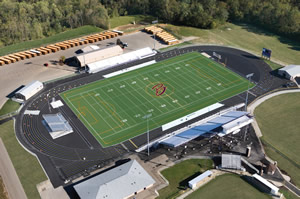
PHOTO COURTESY OF FANNING HOWEY
The stadium also enabled a major partnership with St. Vincent Health, which would not have occurred without the construction. “In this partnership,” says Robison, “we have a school corporate employee clinic that saved us $700,000 in our general fund in the first year by driving people to the clinic instead of the emergency room. In addition, they handle our concussion compliance, sports training, and school nursing. The partnership is a win-win for both the district and St. Vincent.”
The stadium is rented to other organizations when not in use by the district. For example, Boy Scouts, a youth football league, the Rotary Club and more have used it. “In our second year, we were a site for a 240-team soccer tournament, drawing teams from all across the Midwest,” says Robison. “We developed a QR code to help visitors find tables at restaurants. Drawing the revenue strengthened our partnership with the entire community. It’s a host of value added.”
Community use, however, is not the stadium’s foremost purpose. Foremost is the district’s educational program. “High school sports used to be called an accommodation that kept students in school,” says Robison. “But we have an opportunity through clubs, and middle school and high school athletics to cause students to be gainfully occupied in a structured setting. And they learn many of life’s lessons through it, such as teamwork, caring for your health, culture building and ceremony. Nearly 80 percent of our students are active in an extracurricular activity. I fully believe that it’s a lifesaving enterprise in which we engage.”
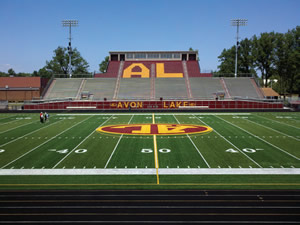
PHOTO COURTESY OF FANNING HOWEY
One of parts of the football stadium in which district administrators can brag is the price tag. Robison explains: “We were in a situation in Indiana where major tax reform was about to occur. The bond money was coveted because we were on a sinking ship in terms of operational funds. With great advice from all audiences, we timed it so we bid $20 million worth of work and got it for $12 million once the recession hit. We got almost $10-million worth of timing-based savings.”
The stadium itself and all of the district’s athletic venues (there is a satellite athletic complex with baseball and softball fields, tennis courts, and practice fields) are not very opulent, especially considering that Zionsville is one of the wealthiest communities in the area. “The facilities are nice but not as tony as some of the districts around us,” Robison notes. “The notion that districts go for opulence and over-the-top Friday night lights doesn’t apply here.”
There you have it. How do you cast your vote: For high-priced, extravagant, and unnecessary, or for what is necessary to provide students with high-quality, well-rounded education?
This article originally appeared in the issue of .